Balun design gives box resonance error in Sonnet
Note: Just rename the attached Multi-Section_Coupled_Line_Balun.txt to Multi-Section_Coupled_Line_Balun.son will let Sonnet open it.
Box Resonance Error
Box resonances estimated for: Multi-Section_Coupled_Line_Balun.son The estimated box resonance frequencies are listed below. The calculations assume lossless materials, with a box filled with only the specified dielectric stackup materials. 6.226 GHZ TM Mode 1,1,0 6.941 GHZ TM Mode 2,1,0 7.006 GHZ TE Mode 1,0,1 7.718 GHZ TE Mode 2,0,1 9.009 GHZ TM Mode 1,1,1 9.153 GHZ TE Mode 0,1,1 9.341 GHZ TE Mode 1,1,1 9.492 GHZ TM Mode 2,1,1 9.884 GHZ TE Mode 2,1,1 Only lowest order modes considered.

Multi-Section_Coupled_Line_Balun.son
FTYP SONPROJ 13 ! Sonnet Project File
DIM
FREQ GHZ
IND NH
LNG MM
ANG DEG
CON /OH
CAP PF
RES OH
END DIM
FREQ
ABS 0.1 10.0
END FREQ
CONTROL
ABS
OPTIONS -d
SPEED 1
CACHE_ABS 1
TARG_ABS 300
Q_ACC N
END CONTROL
GEO
TMET "Lossless" 0 SUP 0 0 0 0
BMET "Lossless" 0 SUP 0 0 0 0
BOX 1 79.359277 23.997124 1250 378 20 0
20 1 1 0 0 0 0 "Air"
2 4.4 1 0.02 0 0 0 "FR-4"
LORGN 0 23.997124 U
POR1 STD
POLY 9 1
3
3 50 0 0 0 79.31161153 0.5693301799
POR1 STD
POLY 13 1
2
2 50 0 0 0 58.93250351 23.99712339
POR1 STD
POLY 25 1
2
1 50 0 0 0 1.146043145 23.98397036
NUM 18
0 6 -1 N 9 1 1 100 100 0 0 0 Y
79.31161153 -0.03337140237
64.26069456 -0.03337140237
64.26069456 1.172031762
79.31161153 1.172031762
79.31161153 -0.03337140237
79.31161153 -0.03337140237
END
0 6 -1 N 10 1 1 100 100 0 0 0 Y
64.26179217 0.3948257219
45.64768726 0.3948257219
45.64768726 0.7945943407
64.26179217 0.7945943407
64.26179217 0.3948257219
64.26179217 0.3948257219
END
0 6 -1 N 11 1 1 100 100 0 0 0 Y
58.72802453 1.602521757
45.64201941 1.602521757
45.64201941 2.002290401
58.72802453 2.002290401
58.72802453 1.602521757
58.72802453 1.602521757
END
0 6 -1 N 12 1 1 100 100 0 0 0 Y
59.12723737 1.602664404
58.72746796 1.602664404
58.72746796 9.612774012
59.12723737 9.612774012
59.12723737 1.602664404
59.12723737 1.602664404
END
0 6 -1 N 13 1 1 100 100 0 0 0 Y
59.5352047 9.606408035
58.32980231 9.606408035
58.32980231 23.99712339
59.5352047 23.99712339
59.5352047 9.606408035
59.5352047 9.606408035
END
0 6 -1 N 14 1 1 100 100 0 0 0 Y
45.64484635 1.798264851
32.84169375 1.798264851
32.84169375 1.999847125
45.64484635 1.999847125
45.64484635 1.798264851
45.64484635 1.798264851
END
0 6 -1 N 15 1 1 100 100 0 0 0 Y
45.65068632 0.3914119619
32.84753407 0.3914119619
32.84753407 0.5929942359
45.65068632 0.5929942359
45.65068632 0.3914119619
45.65068632 0.3914119619
END
0 6 -1 N 16 1 1 100 100 0 0 0 Y
32.84169375 1.600078506
19.93059112 1.600078506
19.93059112 1.999847125
32.84169375 1.999847125
32.84169375 1.600078506
32.84169375 1.600078506
END
0 6 -1 N 17 1 1 100 100 0 0 0 Y
32.84753407 0.3914119619
19.93643107 0.3914119619
19.93643107 0.7911806061
32.84753407 0.7911806061
32.84753407 0.3914119619
32.84753407 0.3914119619
END
0 6 -1 N 18 1 1 100 100 0 0 0 Y
11.52684052 1.399312461
10.92391452 1.399312461
10.92391452 8.582487579
11.52684052 8.582487579
11.52684052 1.399312461
11.52684052 1.399312461
END
0 6 -1 N 19 1 1 100 100 0 0 0 Y
19.93002681 1.399460517
11.52684052 1.399460517
11.52684052 1.997651904
19.93002681 1.997651904
19.93002681 1.399460517
19.93002681 1.399460517
END
0 6 -1 N 20 1 1 100 100 0 0 0 Y
19.93643107 0.3963674765
10.23509144 0.3963674765
10.23509144 0.9945588887
19.93643107 0.9945588887
19.93643107 0.3963674765
19.93643107 0.3963674765
END
0 6 -1 N 21 1 1 100 100 0 0 0 Y
10.83581137 0.9945596507
10.23509144 0.9945596507
10.23509144 7.782923798
10.83581137 7.782923798
10.83581137 0.9945596507
10.83581137 0.9945596507
END
0 6 -1 N 22 1 1 100 100 0 0 0 Y
10.23509144 7.18220407
0.03609072956 7.18220407
0.03609072956 7.782923798
10.23509144 7.782923798
10.23509144 7.18220407
10.23509144 7.18220407
END
0 6 -1 N 23 1 1 100 100 0 0 0 Y
10.93696799 7.981767851
0.7379672786 7.981767851
0.7379672786 8.582487579
10.93696799 8.582487579
10.93696799 7.981767851
10.93696799 7.981767851
END
0 6 -1 N 24 1 1 100 100 0 0 0 Y
0.6390151778 7.782923798
0.03609072956 7.782923798
0.03609072956 23.98320605
0.6390151778 23.98320605
0.6390151778 7.782923798
0.6390151778 7.782923798
END
0 6 -1 N 25 1 1 100 100 0 0 0 Y
1.554119012 8.582487579
0.7379672786 8.582487579
0.7379672786 23.98397036
1.554119012 23.98397036
1.554119012 8.582487579
1.554119012 8.582487579
END
0 6 -1 N 26 1 1 100 100 0 0 0 Y
2.304036029 9.983319474
1.652782746 9.983319474
1.652782746 23.98161545
2.304036029 23.98161545
2.304036029 9.983319474
2.304036029 9.983319474
END
END GEO
OPT
MAX 100
VARS
END
END OPT
VARSWP
END VARSWP
QSG
IMPORT YES
EXTRA_METAL YES
UNITS YES
ALIGN YES
REF NO
VIEW_RES NO
METALS NO
USED YES
END QSG
Do you realize that the Sonnet box wall is a metal boundary? Like a metal box? You have a line from port 3 directly at the box wall, that looks wrong to me. Also, the lines at port 1 might not be what you really want ...
Post a sketch what your design should look like. It's difficult to see from your Sonnet model what ground connection is intended and what is user mistake.
For the box resonance, did you check the Sonnet manual? Air layer thickness and top conver "free space" are something to look at.
Well, this is not planar marchand balun. This balun topology does not require vias connections to ground.
By the way, you can just run the Multi-Section_Coupled_Line_Balun.son design file using only free SonnetLite software

I don't need Sonnet Lite because I have Sonnet Professional and was part of the Sonnet support team for many years. That's why I say your model looks totally wrong!
Sure, but you have several of your lines VERY close to the METAL SIDE WALLS.
Some lines touch it, that creates a connection to ground.
Some are close, that changes the line behaviour.
But just like the other thread, you don't answer my questions. Then it's a waste of time to answer here, so: Good luck!
I have already tried modifying the box size, but it does not really help.

You're closing the Box with Perfect Conductor and 20mm Height is not enough.Make the Box Free Space Enclosure or increase the Air Height..
You have multiple mistakes in your model.
At least you have now removed the short circuit between the feedline at port 3 and the box wall.
The next question is if the two lines left and right from port 1 must be shorted to ground? At the moment, they are shorted to ground because they connect to the box wall.
One of multiple issues is to fix the box resonance issue. I changed top cover to free space and reduced (!) the box height to 10mm. It seems that is enough to supress the box modes.
Model is attached below.
Now you need to fix the other issues, e.g. lines left and right from port 1 grounded by touching wall, which might be correct or not.
Then, you can think about making resu?ts more accurate (mesh, thick metal).
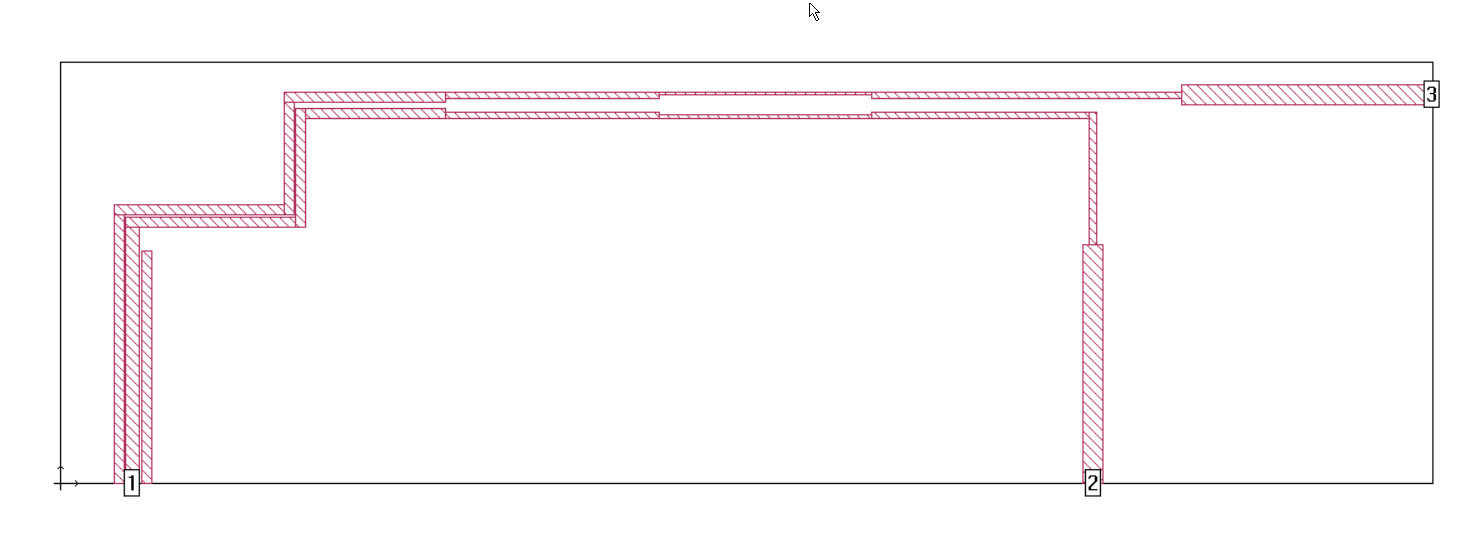
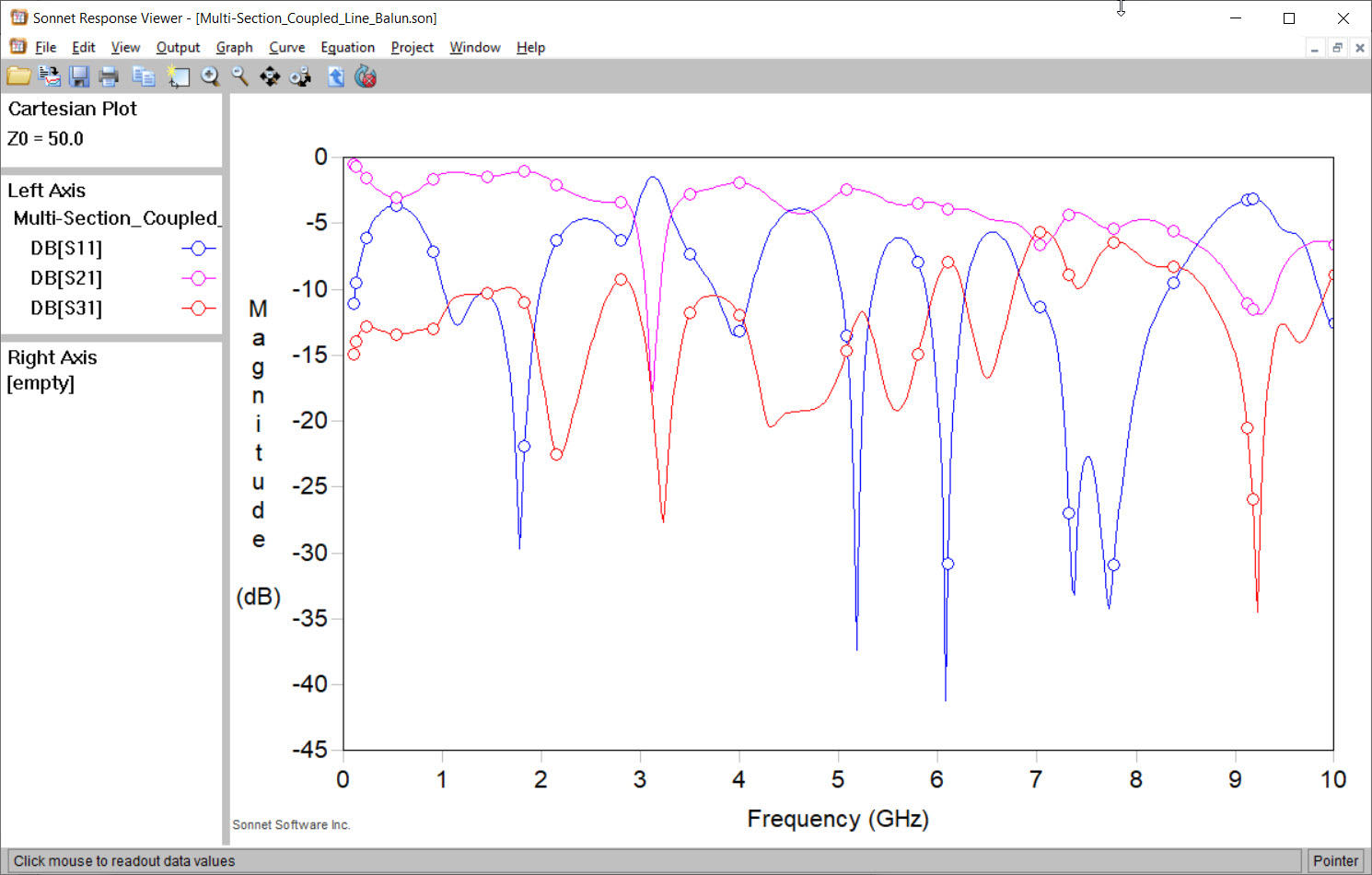
Multi-Section_Coupled_Line_Balun.zip
Free space as in vacuum ? then this will only work well within simulation.
I already tried to increase the Air layer height to 40mm , but I just got more box resonance errors.
Circuit > Box > Covers
Yes, the metal box causes box resonances and that is a real effect. The practical solution is the same what "free space" setting in Sonnet does: using absorbing material at the cover, to take out the radiated energy that would otherwise cause box modes.
~~
Don't miss my post #7 above.
Are you sure about materials and/or dimensions? The feed line width of w=1.2mm on 2mm FR4 gives line impedance around 80 Ohm ...
I downloaded your zip file but I still find that box resonance errors are still not suppressed as you had stated in post #7
Did I miss anything ?

Wait, which segment were you referring to ? and what is wrong with around 80 ohms ? There is no impedance transformer here though


Yes, you miss something. That dialog shows possible box modes based on box dimensions. It does not evaluate if the box modes are actually excited, or surpressed by free space absorbing boundary.
One test for the actual presence of box mode is to have a model with just the feed structure, and see if you get sharp resonances (the box modes) in reflection or transmission. As you can see, it is all smooth and flat in "my" model, so there is no issue with box modes for my configuration.

For comparison, this is what you get when the "free space" is changed to "lossless" top cover:
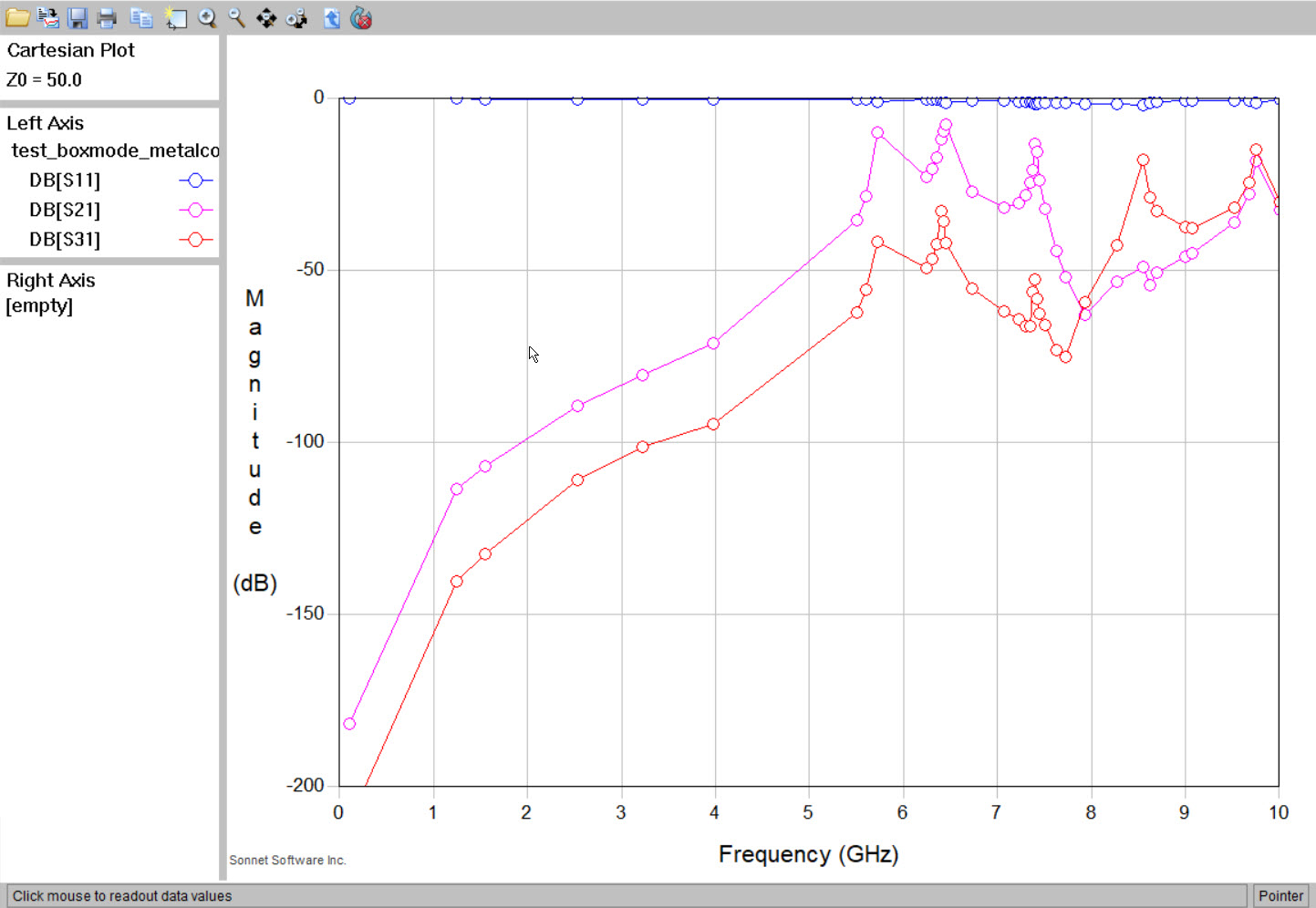
With the metal box all around, there are multiple box resonances visible in results. You will notice that adaptive frequency sweeps takes many extra points to modell all those resonances. Solution as shown above: with top cover changed to "free space" these resonances are all gone.
Nothing is wrong with 80 Ohm if this is what you designed. I just expected the feed lines at port 2 and 3 to be 50 Ohm, as usual.
The part that I'm still not sure about, after looking at your reference drawing: how to interpret these ends of the lines next to port1? Is that meant to be open or grounded? In your Sonnet model it's grounded to the box.
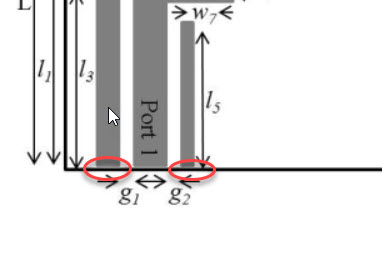
Wait, why just the feed structure for this box mode test ?
I am not sure. I need to email the original authors of the paper regarding this. I will get back to this post once they reply.
Besides, something else is not right with the layout or ports. See the phase difference (S12-S13)

This uses the feed structure as a "probe" to excite the box modes. Sonnet box = cavity resonator, feed lines couple into that resonator. If there is no spurious transmission in that case, your actual model results should be good. At least for these low order box modes.
(It's a bit more complex that what I describe here, but I try to keep it simple).
That might be a result of the balun at port 1 with the open/ground uncertainty. When you contact the authors, also ask about the substrate that they used. I doubt they used 2mm FR4.
See page 4 of the paper

Ok, then the ground connection by touching the box walls is perfectly correct!
The substrate is also specified: er=4.2 with 1.5mm thickness (not 2.0mm as in your Sonnet model). But then, for the 50 Ohm mentioned in the paper, the feed line width at ports 2/3 would much wider than the 1.2mm found in your model. Something is wrong there.
I have drawn the layout precisely in AutoCad as mentioned in the paper and there are some dimension errors.I couldn't catch the electrical response in AWR Axiem and Sonnet..
Something else is not right.
I have attached the Sonnet design file at the end of this post


How did you calculate the width and gap in the coupled line sections?
The coupled line sections all line up exactly at the outside, so are the gaps actually calculated?
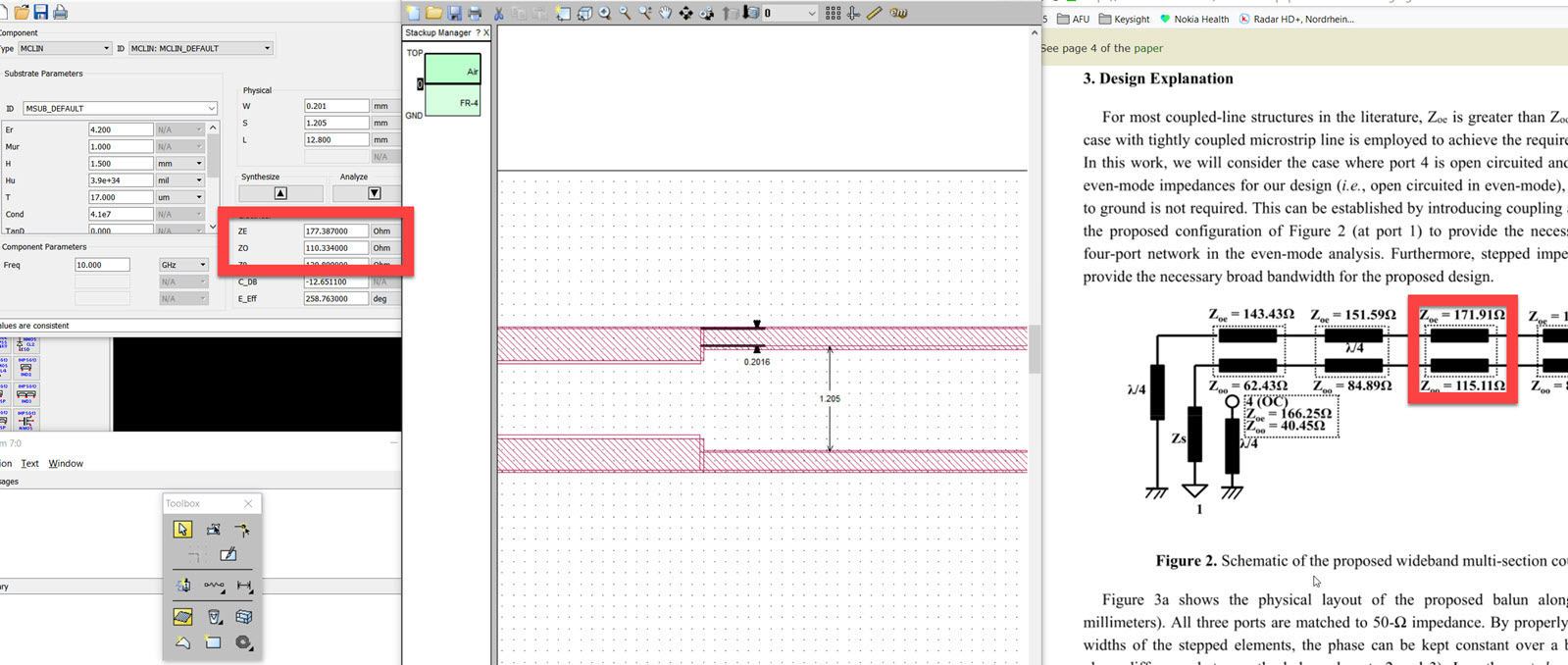
~~
Another (fundamental) issue is that your simulation mesh is rather coarse, and Sonnet will simulate the geometry snapped to that coarse grid. You would need a smaller cell size for accurate results, to capture the true gap width and line width.
~~
But it seems that Bigboss has already simulated using fine mesh, with results that don't agree, so there is something wrong with the layout also.
Volker,
Controlled Impedance Analyzer and Transmission Line Tool give different results for Edge-to Edge Coupled Lines for the same Input data, do you know why ?
Sorry, no idea, I never used Controlled Impedance Analyzer and don't know what method they use.
